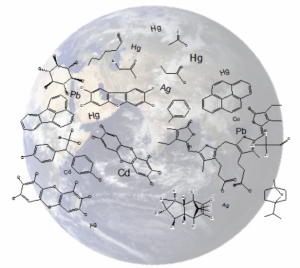February 2015: Toxics: It’s a Small World After All
In this edition:
- Planetary Boundaries: It’s a Small World for Toxics After All
- When Deciding What to Do with Your Old Couch, Consider the Birds
- FRs – short for Flame Retardants, and for Fat Rats
- Flame Retardants May Contribute to Preterm Births
- Triclosan Promotes Liver Tumor Growth in Mice

This month the Green Science Policy Institute and our friends and colleagues came together in workshops to smooth the transition to the new California furniture flammability standard. We learned about the long history leading to safer and healthier furniture without flame retardants. You can view some of the talks presented here and see a list of some companies that sell furniture without added flame retardants here.
Also I was recently honored to receive the annual Thomas Lamb Eliot award for lifetime achievement of a Reed College graduate. I’d planned to ski on nearby Mt. Hood where I’d first learned to climb, but there was no snow. Even Oregon is experiencing an unprecedented drought.
For a big picture view of the need for the reduction in the use of toxic chemicals, take a look at Miriam Diamond’s new paper “Exploring the Planetary Boundary for Chemical Pollution“ discussed below.
The good news is that we can learn about Six Classes containing many of the harmful chemicals in everyday products. With this information, manufacturers, retailers, and large purchasers can reduce the use of entire chemical classes and we can all be healthier. Please check out our short webinars here and contact us if you’d like to be more involved with this innovative effort.
Kind regards,
Arlene and the Green Science Policy team
Planetary Boundaries: It’s a Small World for Toxics After All

The central concept of Miriam Diamond and co-authors’ visionary paper “Exploring the Planetary Boundary for Chemical Pollution” is that planet Earth has a finite capacity for chemical pollution beyond which human health and ecosystems survival are threatened. Reducing individual chemical emissions, while the total amount increases, is leading to irreversible harm. This paper demonstrates that many chemicals in commerce need to be used with much more prudence and precaution. The following four new scientific papers bolster this conclusion.
When Deciding What to Do with Your Old Couch, Consider the Birds

A new study found that Michigan’s bald eagles contain high concentrations of phased-out flame retardants (PBDEs) “among the highest found in liver tissues of any wildlife.” The impacts for bald eagles are not yet known, but studies on other birds have linked PBDE exposures to reproductive problems in male birds, lower nest temperatures, smaller eggs with thinner shells, delayed egg laying, and odd behavior such asfewer mating calls and eating less.
Flame retardants migrate out of products currently in use, and leach out of landfills. Therefore, if you live in the San Francisco Bay Area, consider our safer sofa foam exchange, which aims to reduce household exposure and keep toxic sofas out of landfills.
FRs – short for Flame Retardants, and for Fat Rats
Researchers at the University of New Hampshire exposed laboratory rats to flame retardant chemicals (PBDEs) and found a strong link to “metabolic and liver problems that can lead to insulin resistance…a major cause of obesity”. This may be due to “the suppression of a key metabolic enzyme…which is responsible for sugar and fat metabolism”. The study also found FR-exposed rats developed enlarged livers. Dr. Gale Carey notes, “there is a growing body of experimental evidence suggesting certain environmental chemicals, or ‘obesogens’,… [may be contributing] to the obesity epidemic”. Read more here.
Flame Retardants May Contribute to Preterm Births
A recent study found that women with higher levels of the flame retardant PBDE-47 in their blood were more likely to have preterm births than women with lower levels. PBDEs are similar in structure to PBBs, PCBs, dioxins, and furans. The Stockholm Convention has banned certain types of these human toxicants. In the U.S., some PBDEs have been phased outbut have been replaced with harmful or untested substitutes.
Triclosan Promotes Liver Tumor Growth in Mice

The National Institute of Environmental Health Sciences reports on a study that found that “long-term exposure to triclosan promotes the growth of liver tumors in laboratory mice, raising concerns about its safety for humans.” Scientists found that triclosan “interferes with [a] receptor, which plays a role in detoxifying the blood…which can lead to fibrosis and cancer.” The FDA is reviewing triclosan’s safety because it may alter hormone regulation and contribute to making bacteria resistant to antibiotics. Learn more in the Six Classes Antimicrobials webinar.
Receive Updates By Email
Subscribe to our monthly newsletter and get these updates delivered right to your inbox!